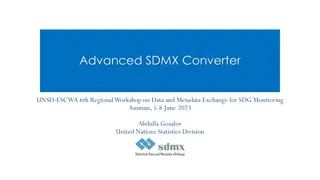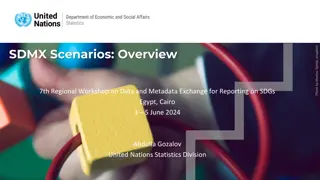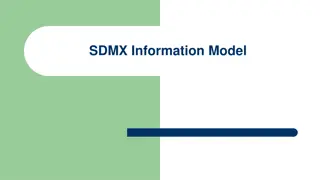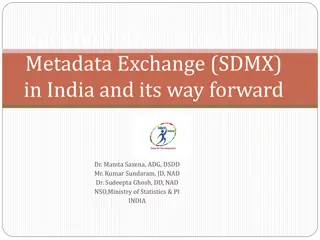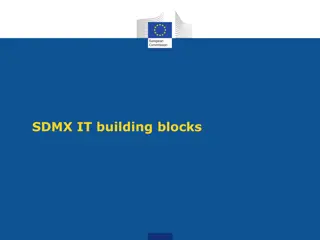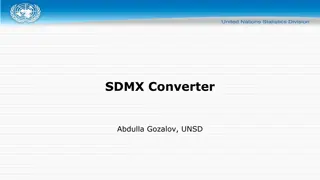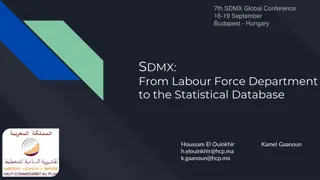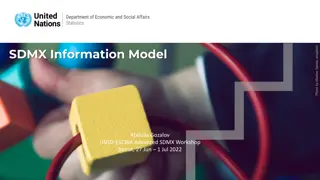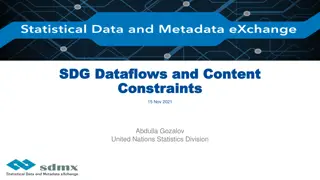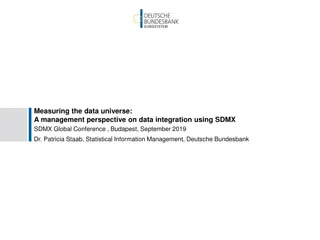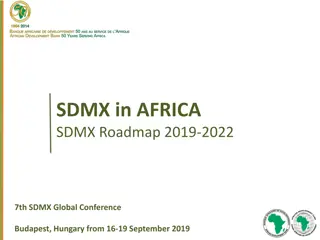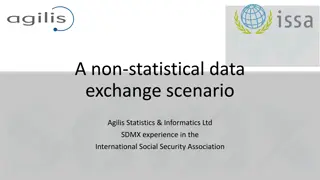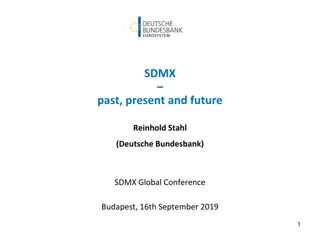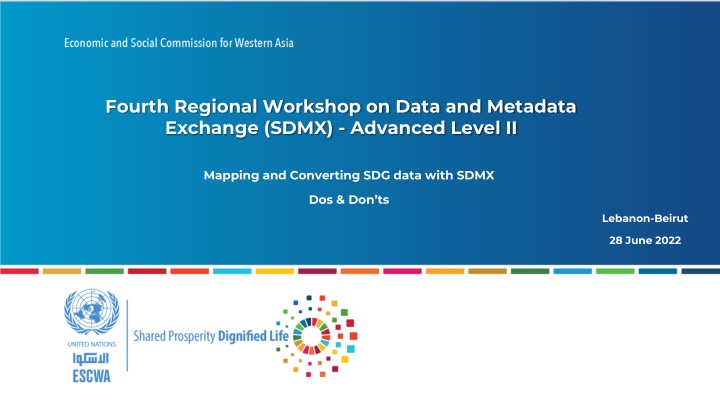
SDMX Data Exchange Workshop in Lebanon
The Fourth Regional Workshop on Data and Metadata Exchange (SDMX) at an advanced level focuses on mapping and converting SDG data using SDMX in Beirut, Lebanon on 28 June 2022. The workshop explores the SDMX Data Cube Model and Concept Scheme to enhance understanding and utilization of data points, dimensions, and attributes. It delves into the role of Data Structure Definition (DSD) in representing data models and concepts. Participants learn about the global SDG DSD with its 32 concepts and how wildcard dimensions can support various breakdowns effectively. Insightful discussions on dimensions, attributes, and code lists enrich the participants' knowledge in efficiently handling SDG data.
Download Presentation

Please find below an Image/Link to download the presentation.
The content on the website is provided AS IS for your information and personal use only. It may not be sold, licensed, or shared on other websites without obtaining consent from the author. If you encounter any issues during the download, it is possible that the publisher has removed the file from their server.
You are allowed to download the files provided on this website for personal or commercial use, subject to the condition that they are used lawfully. All files are the property of their respective owners.
The content on the website is provided AS IS for your information and personal use only. It may not be sold, licensed, or shared on other websites without obtaining consent from the author.
E N D
Presentation Transcript
Fourth Regional Workshop on Data and Metadata Exchange (SDMX) - Advanced Level II Mapping and Converting SDG data with SDMX Dos & Don ts Lebanon-Beirut 28 June 2022
SDMX Data Cube Model Each data point is characterised by: Primary Measure Observed values on one or more variables of interest. Dimensions Attributes A set of uniquely identifying characteristics. A set of additional characteristics that further describe it. In SDMX, the data model is represented by a Data Structure Definition (DSD)
SDMX Concept Scheme In SDMX, each dimension, measure and attribute encapsulates a concept. The Set of Concepts that are used in a Data Structure Definition (DSD) or Metadata Structure Definition (MSD) is known as a Concepts Scheme. Representation of a concept: o Coded: I. Drawn from a code list* (for e.g., country ISO code ), for example, AGE, SEX, URBANISATION, REF_AREA, NATURE, etc. o Un-coded with a format: I. Required to adhere to a specific data format (e.g., YYYY for years), for example, TIME_PERIOD, DATA_LAST_UPDATE, BASE_PER, TIME_COVERAGE, etc. II. Required to be contained within a specific range of values (e.g., numerical values between 0 and 1 ) for example, OBS_VALUE, UPPER_BOUND, LOWER_BOUND. o Un-coded free text: I. Drawn from a type of values (e.g., text ), for example, SOURCE_DETAIL, COMMENT_OBS, COMMENT_TS, CUST_BREAKDOWN_LB, TIME_DETAIL$ etc. A predefined list from which some statistical coded concepts take their values. $ It can be a date, also a footnote, e.g., "Survey ran from 1 Jul 2021 - 30 Jun 2022"
Data Structure Definition (DSD) Reference Reference DSD Code lists Concept Scheme Concept Concept ID Role Attachment Representation Code list ID Indicator INDICATOR Dimension Code List CL_INDICATOR Reference area REF_AREA Dimension Code List CL_REF_AREA Time period TIME_PERIOD Dimension YYYY Unit multiplier UNIT_MULT Attribute Time series Code List CL_UNIT_MULT Obs. value OBS_VALUE Pr. Measure Number
Data Structure Definition (DSD) (2) The global SDG DSD has 32 concepts, including 16 dimensions, 15 attributes, and the primary measure. These include 2 wildcard (multi-purpose) dimensions, COMPOSITE_BREAKDOWN and CUST_BREAKDOWN, which can be used to support multiple breakdowns. The multi-purpose dimensions play a key role in the customization of the DSD. Dimensions Attributes FREQ URBANISATION SEX TIME_COVERAGE GEO_INFO_URL OBS_STATUS REPORTING_TYPE EDUCATION_LEV AGE UNIT_MEASURE GEO_INFO_TYPE COMMENT_OBS REF_AREA ACTIVITY UNIT_MULT COMPOSITE_BREAKDOWN COMMENT_TS CUST_BREAKDOWN_LB SERIES PRODUCT SOURCE_DETAIL CUST_BREAKDOWN UPPER_BOUND TIME_PERIOD INCOME_WEALTH_QUALNTILE TIME_DETAIL LOWER_BOUND OCCUPATION DISABILITY_STATUS DATA_LAST_UPDATE BASE_PER The code lists for SDMX SDG DSD concepts, are available in the SDG_DSD_MATRIX.xlsm excel macro file.
SDMX Dataflows (DF) Dataflow defines a view on a Data Structure Definition (DSD). It is a structure that can help describe, categorize and constrain datasets. Each data flow is linked to one DSD. Each DSD may have one or more dataflows linked to it. In its simplest form defines any data valid according to a DSD. SDG Global Dataflows (DF) o DF_SDG_GLH Harmonized Global Dataflow. This data flow is used by the Custodian Agencies to report SDG indicators that are part of the global dataset, regardless of how the data was obtained. o DF_SDG_GLC Country Global Dataflow. This data is used by countries to report data to UNSD and ESCWA, as well as to disseminate national data in compliance with the SDG Global DSD.
SDMX Content Constraints (CN) Content constraints define restrictions on code lists or series, it can be used to define which combinations of codes are allowed: o For example, SERIES= Proportion of Women in National Parliament SEXmust be FEMALE Constraints can define more granular validation rules than a simple validation of codes. Are often attached to the Dataflow but can also be attached to DSD, but wherever content constraints are attached, code lists that they restrict are defined in the underlying DSD. Types of SDMX Content Constraints (CN) Cube Region: Define allowed (or disallowed) codes from DSD code lists. Series: Define allowed (or disallowed) combinations of codes from DSD code lists.
SDG Cube Region Content Constraints (CN) CN_SDG_GLC, attached to dataflow DF_SDG_GLC: o Restricts the dimension REPORTING_TYPE to code N ( National ). CN_SDG_GLH, attached to dataflow DF_SDG_GLH: o Restricts the dimension REPORTING_TYPE to code G ( Global ). SDG Cube Series Content Constraints (CN) CN_SERIES_SDG_GLC, attached to dataflow DF_SDG_GLC CN_SERIES_SDG_GLH, attached to dataflow DF_SDG_GLH The Data Structure Definition (DSD), Data Flows (DF) and the Series of Content Constraints (CN) can be downloaded from: o The SDMX Global Registry or SDMX-SDG page.
Transcoding Transcoding refers to code mapping when internal codes are different from DSD codes. For conversion to work, internal codes need to be replaced with DSD codes. Transcoding can also be stored in external files. This is very useful when multiple sheets need to be mapped and reused. The use of a single code for no breakdown (e.g., for Total and Not Applicable) simplifies the mappings. Inconsistent mappings and transcoding lead to duplications and other anomalies.
Coding Nature & Reporting Type Do the coding for the following scenarios: I. S1- You have in the dataset data retrieved from the global database with nature CountryAdjusted , what would you expect in the attribute NATURE, and the REPORTING_TYPE? II. S2- You have in the National data retrieved from the MICS report, how would you code the attribute NATURE, and the REPORTING_TYPE? III. For the two scenarios above, you are using the dataflow to convert the data, which dataflow you should use for each scenario?
Coding Nature & Reporting Type solution Do the coding for the following scenarios: I. S1- You have in the dataset data retrieved from the global database with nature CountryAdjusted , what would you expect in the attribute NATURE, and the REPORTING_TYPE? o Answer: REPORTING_TYPE: G || NATURE: CA II. S2- You have in the National data retrieved from the MICS report, how would you code the attribute NATURE, and the REPORTING_TYPE? o Answer: REPORTING_TYPE: N || NATURE: C III. For the two scenarios above, you are using the dataflow to convert the data, which dataflow you should use for each scenario? o Answer: S1-DF_SDG_GLH || S2- DF_SDG_GLC
Coding Unit Measure & Unit Multiplier series indicator UNIT_MEASURE UNIT_MULT SI_POV_DAY1 [1.1.1] Proportion of population below international poverty line (%) SN_ITK_DEFCN [2.1.1] Number of undernourished people, thousands AG_PRD_XSUBDY [2.b.1] Agricultural export subsidies, billion USD dollars SH_STA_MORT [3.1.1] Maternal mortality ratio, per 100,000 live births SH_STA_TRAF [3.6.1] Death rate due to road traffic injuries, per 100,000 population SH_ACS_UNHC [3.8.1] Universal health coverage (UHC) service coverage index EN_WBE_PMNR [6.6.1] Water body extent (permanent) (square kilometres) EN_ATM_CO2 [9.4.1] Carbon dioxide emissions from fuel combustion, in million tones GB_POP_SCIERD [9.5.2] Researchers (in full-time equivalent) per million inhabitants EN_LND_CNSPOP [11.3.1] Ratio of land consumption rate to population growth rate AG_LND_TOTL [15.1.1] Land area (thousands hectares) GR_G14_XDC [17.1.1] Total government revenue, in trillion local currency IT_USE_II99 [17.8.1] Internet users per 100 inhabitants
Coding Unit Measure & Unit Multiplier solution series indicator UNIT_MEASURE UNIT_MULT PT 0 SI_POV_DAY1 [1.1.1] Proportion of population below international poverty line (%) NUMBER 3 SN_ITK_DEFCN [2.1.1] Number of undernourished people, thousands USD 9 AG_PRD_XSUBDY [2.b.1] Agricultural export subsidies, billion USD dollars PER_100000_LIVE_BIRTHS 0 SH_STA_MORT [3.1.1] Maternal mortality ratio, per 100,000 live births PER_100000_POP 0 SH_STA_TRAF [3.6.1] Death rate due to road traffic injuries, per 100,000 population IX 0 SH_ACS_UNHC [3.8.1] Universal health coverage (UHC) service coverage index KM2 0 EN_WBE_PMNR [6.6.1] Water body extent (permanent) (square kilometres) [9.4.1] Carbon dioxide emissions from fuel combustion, in million tones T 6 EN_ATM_CO2 PER_1000000_POP 0 GB_POP_SCIERD [9.5.2] Researchers (in full-time equivalent) per million inhabitants RO 0 EN_LND_CNSPOP [11.3.1] Ratio of land consumption rate to population growth rate HA 3 AG_LND_TOTL [15.1.1] Land area (thousands hectares) CUR_LCU 12 GR_G14_XDC [17.1.1] Total government revenue, in trillion local currency PER_100_POP 0 IT_USE_II99 [17.8.1] Internet users per 100 inhabitants
Exercise (1) indicator series age sex locat* educat* activity quantile comp_break* unit_measure mult. [2.2.1] Number of children stunted (thousands) SH_STA_STNT Y0T5 _T _T _T _T _T _T NUMBER 0 [4.1.1] Children in secondary school achieving a minimum level in reading (%) SE_TOT_PRFL _T _T _T _T _T SKILL_READ PERCENT 0 ISCED11_2 [9.2.1] Manufacturing value added per capita (million constant USD) NV_IND_MANF _T _T _T _T ISIC_C _T _T CON_USD 0 [[3.2.1] Under-five mortality rate per 1,000 live births, female SH_DYN_MORTN 0T4Y _F _T _T _T _T _T PER_1000_POP 0 [3.2.1] Infant mortality rate per 1,000 live births, rural SH_DYN_IMRT Y1 _T _U _T _T _T _T PER_1000_POP 0 [3.2.1] Number of neonatal mortality, male urban SH_DYN_NMRT M0 _M _R _T _T _T _T NUMBER 0 [5.3.1] Urban women aged 20-24 years married before age 18 (%) SP_DYN_MRBF15 Y20T24 _F _T _T _T _T _T PER_MARW_20T24Y 0 [9.1.1] The rural population who live within 2 km of an all-season road (%) SP_ROD_R2KM _T _T _R _T _T _T _T PERCENT 0 [11.1.1] Urban population living in slums (number) EN_LND_SLUM _T _T _U _T _T _T _T NUMBER 0 [17.8.1] Users of the internet (256 kbps to 2 Mbps)per 100 inhabitants IT_USE_ii99 _T _T _T _T _T _T IS_2MT10M PERCENT 0
Exercise (1) - solution indicator series age sex locat* educat* activity quantile comp_break* unit_measure mult. [2.2.1] Number of children stunted (thousands) SH_STA_STNTN Y0T4 _T _T _T _T _T _T NUMBER 3 [4.1.1] Children in secondary school achieving a minimum level in reading (%) SE_TOT_PRFL _T _T _T AGG_2_3 _T _T SKILL_READ PT 0 [9.2.1] Manufacturing value added per capita (million constant USD) NV_IND_MANFPC _T _T _T _T ISIC4_C _T _T CON_USD 9 [3.2.1] Under-five mortality rate per 1,000 live births, female SH_DYN_MORT Y0T4 F _T _T _T _T _T PER_1000_LIVE_BIRTHS 0 [3.2.1] Infant mortality rate per 1,000 live births, rural SH_DYN_IMRT Y0 _T R _T _T _T _T PER_1000_LIVE_BIRTHS 0 [3.2.1] Number of neonatal mortality, male urban SH_DYN_NMRTN M0 M U _T _T _T _T NUMBER 0 [5.3.1] Urban women aged 20-24 years married before age 18 (%) SP_DYN_MRBF18 Y20T24 F U _T _T _T _T PT 0 [9.1.1] The rural population who live within 2 km of an all-season road (%) SP_ROD_R2KM _T _T R _T _T _T _T PT 0 [11.1.1] Urban population living in slums (number) EN_LND_SLUMN _T _T U _T _T _T _T NUMBER 0 [17.8.1] Users of the internet (256 kbps to 2 Mbps)per 100 inhabitants IT_USE_II99 _T _T _T _T _T _T IS_256KT2M PER_100_POP 0
Exercise (2) indicator series age sex locat* quantile disability_status comp_break* unit_measure mult. [2.c.1] Countries recording moderately high food prices (%) [4.6.1] Population achieving a fixed level of proficiency in writing a computer program in specialized languages (%) [8.10.2] Account ownership at a financial institution, richest 60% ( age 25+) (%) [1.1.1] Youth rural population below the international poverty line (%) [1.3.1] Mothers with newborns receiving a maternity cash benefit (%) [3.7.2] Adolescent birth rate per 1,000 women aged 15-19, urban [7.1.1] Urban population with access to electricity (%) [8.5.2] The unemployment rate, for male disabled youth in the rural area (%) [15.1.1] Forest area (hectares) [16.9.1] Rural children under 5 years of age with birth registered (%), female
Exercise (2) - solution indicator series age sex locat* quantile disability_status comp_break* unit_measure mult. [2.c.1] Countries recording moderately high food prices (%) AG_FPA_HMFP _T _T _T _T _T SPL_M PT 0 [4.6.1] Population achieving a fixed level of proficiency in writing a computer program in specialized languages (%) SE_ADT_FUNS _T _T _T _T _T SKILL_ICTPRGM PT 0 [8.10.2] Account ownership at a financial institution, richest 60% ( age 25+) (%) FB_BNK_ACCSS Y_GE25 _T _T R60 _T _T PT 0 [1.1.1] Youth rural population below the international poverty line (%) SI_POV_DAY1 Y14T25 _T R _T _T _T PT 0 [1.3.1] Mothers with newborns receiving a maternity cash benefit (%) SI_COV_MATNL _T F _T _T _T _T PT 0 [3.7.2] Adolescent birth rate per 1,000 women aged 15-19, urban SP_DYN_ADKL Y15T19 F U _T _T _T PER_1000_POP 0 [7.1.1] Urban population with access to electricity (%) EG_ACS_ELEC _T _T U _T _T _T PT 0 [8.5.2] The unemployment rate, for male disabled youth in the rural area (%) SL_TLF_UEMDIS Y14T25 M R _T PD _T PT 0 [15.1.1] Forest area (hectares) AG_LND_FRSTN _T _T _T _T _T _T HA 3 [16.9.1] Rural children under 5 years of age with birth registered (%), female SG_REG_BRTH Y0T4 F R _T _T _T PT 0
Mapping and Position Types SDMX supports the following position types: o COLUMN: When value for the entire dataset is provided in the cell provided in the column Position. o ROW: Values for the concept are stored in the row specified in column Position o FIX: Fixed value for the entire dataset is stored in the column Position and does not appear in the data spreadsheet o MIXED: Allows to use two types of mapping interchangeably, reducing burden do the transcoding for all dataset. o SKIP:The concept value is not mapped, it can only be used with optional attributes*, it can t be used for dimensions. * Mandatory Attributes are : OBS_STATUS, UNIT_MEASURE, UNIT_MULT.
Data presentation types (wide cross-tab vs long time series) Long time series format
Using the Desktop-Based SDMX Converter 1. Select: Convert and Validate 2. Select the data file 3. Make sure the input format is Excel 4. Select output format: STRUCTURE_SPECIFIC_DATA_2_1 5. Enter the output file name .xml extension 6. Click Next
Using the Desktop-Based SDMX Converter (2) 7. Select: DSD or Dataflow 8. Select the DSD file 9. Click Next
Using the Desktop-Based SDMX Converter (3) 10. Check Manual Config 11. Click Next
Using the Desktop-Based SDMX Converter (4) 12. Click Next
Using the Desktop-Based SDMX Converter (5) 13. Validate Results
Validation of SDG datasets Validation against the DSD verifies that all dimensions and mandatory attributes are in place. o Does not verify relationships between the dimension values. If you have the series Forest area as a proportion of total land area with Sex=Female, it will pass the validation. Validation against a data flow, in addition, verifies relationships among dimension values. o Will flag invalid combinations such as the above, gender indicators with Sex=Male, and similar coding errors. o Helps validate the dataset before submitting it to the SDG Lab, which will reject invalid datasets. Countries should always validate against dataflow DF_SDG_GLC for the data used by countries to report data to UNSD and ESCWA, as well as to disseminate national data in compliance with the SDG Global DSD.
Interpreting SDMX Converter Error Messages - Types Type 1: Duplicate observation; could be the result of incorrect transcoding. Validating Using DSD Type 2: Use of invalid representation in a code list. Type 3: Not allowed specification i.e., the content constraint is not satisfied. Validating Using DF_SDG_GLC Type 4: Illegal specification in dimension REPORTING_TYPE, i.e., the result of using wrong data flow for validation. Validating Using DF_SDG_GLH Type 5: Incorrect or missing the mapping of parameters, such as wrong position or skipping a mandatory concept.
Dos & Donts Map internal code lists to DSD code lists. Preferably store transcoded codes in external files. Familiarity with the SDG DSD code lists. Familiarity with SDG Content Constraint. Avoid adding unnecessary columns, if they can be mapped using FIX as the type of the position. Check if the attribute UNIT_MULT is specified correctly. Validate against dataflow DF_SDG_GLC REPORTING_TYPE= N. Review SDMX converter error messages and correct them, until you get no error. Review your coding and transcoding, even if the converter doesn t report any error. Practice, Practice, and Practice!
Useful Links Link Java https://java.com/en/download/ Desktop SDMX Converter https://bit.ly/3CwdjiA Europa SDMX Online Converter https://bit.ly/3HA28cg ESCWA - Series of SDMX Trainings https://bit.ly/3y51Kzg ESCWA - SDMX Crash Course I https://bit.ly/3MZQ5Gc ESCWA - SDMX Crash Course II https://bit.ly/3xXnhse SDMX Global Registry https://registry.sdmx.org/overview.html SDMX SDG Page https://bit.ly/3zSWUX9 SDG Metadata Template https://bit.ly/3N9B1ps SDG Metadata SDMX Converter https://bit.ly/39Fvmdc
Questions & Groups Exercises!


